traction control Hyundai Equus 2016 Owner's Manual
[x] Cancel search | Manufacturer: HYUNDAI, Model Year: 2016, Model line: Equus, Model: Hyundai Equus 2016Pages: 477, PDF Size: 16.25 MB
Page 20 of 477
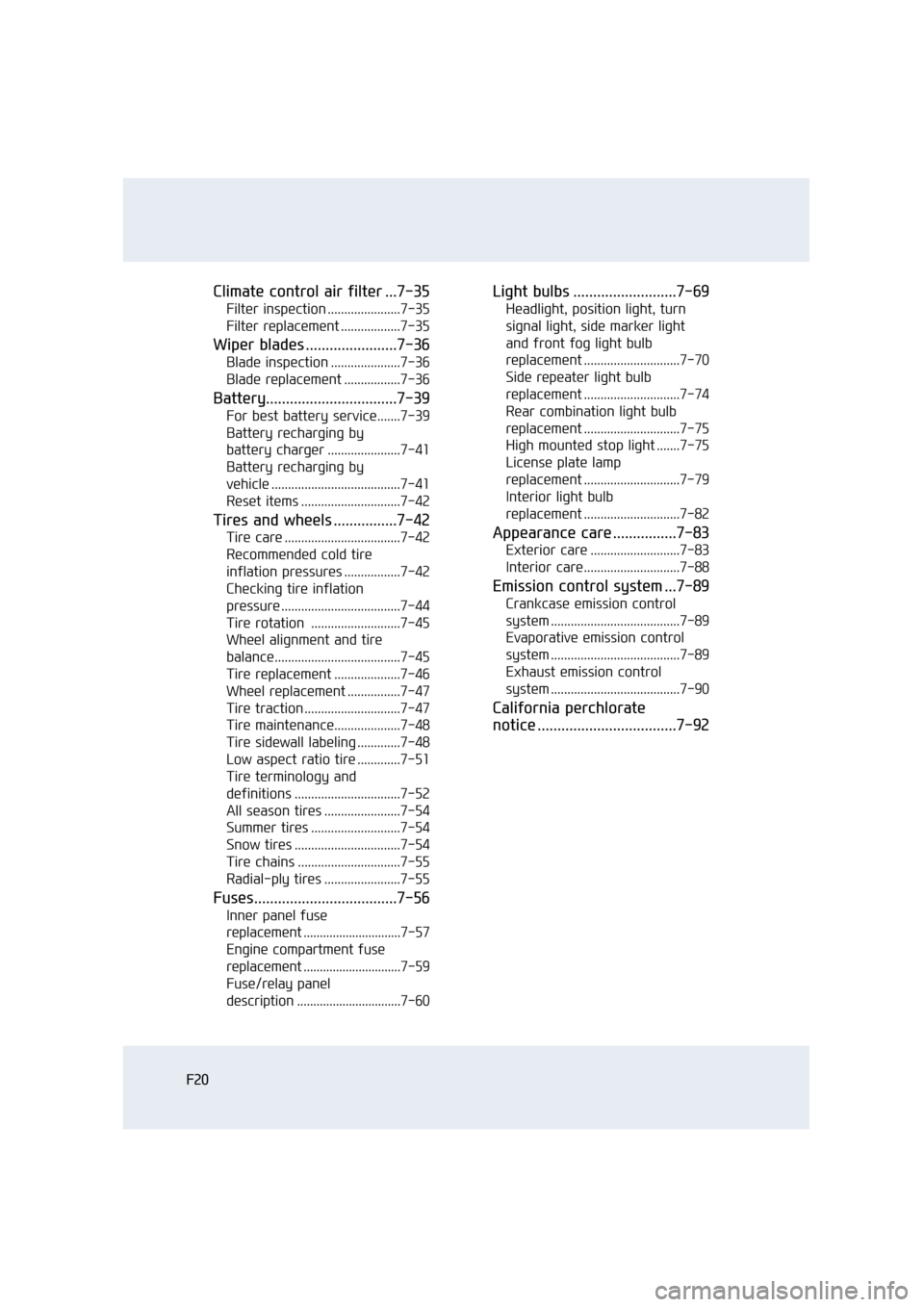
F20
Climate control air filter ...7-35
Filter inspection ......................7-35
Filter replacement ..................7-35
Wiper blades .......................7-36
Blade inspection .....................7-36
Blade replacement .................7-36
Battery.................................7-39
For best battery service.......7-39
Battery recharging by
battery charger ......................7-41
Battery recharging by
vehicle .......................................7-41
Reset items ..............................7-42
Tires and wheels ................7-42
Tire care ...................................7-42
Recommended cold tire
inflation pressures .................7-42
Checking tire inflation
pressure ....................................7-44
Tire rotation ...........................7-45
Wheel alignment and tire
balance......................................7-45
Tire replacement ....................7-46
Wheel replacement ................7-47
Tire traction .............................7-47
Tire maintenance....................7-48
Tire sidewall labeling .............7-48
Low aspect ratio tire .............7-51
Tire terminology and
definitions ................................7-52
All season tires .......................7-54
Summer tires ...........................7-54
Snow tires ................................7-54
Tire chains ...............................7-55
Radial-ply tires .......................7-55
Fuses....................................7-56
Inner panel fuse
replacement ..............................7-57
Engine compartment fuse
replacement ..............................7-59
Fuse/relay panel
description ................................7-60
Light bulbs ..........................7-69
Headlight, position light, turn
signal light, side marker light
and front fog light bulb
replacement .............................7-70
Side repeater light bulb
replacement .............................7-74
Rear combination light bulb
replacement .............................7-75
High mounted stop light .......7-75
License plate lamp
replacement .............................7-79
Interior light bulb
replacement .............................7-82
Appearance care ................7-83
Exterior care ...........................7-83
Interior care.............................7-88
Emission control system ...7-89
Crankcase emission control
system .......................................7-89
Evaporative emission control
system .......................................7-89
Exhaust emission control
system .......................................7-90
California perchlorate
notice ...................................7-92
Page 266 of 477
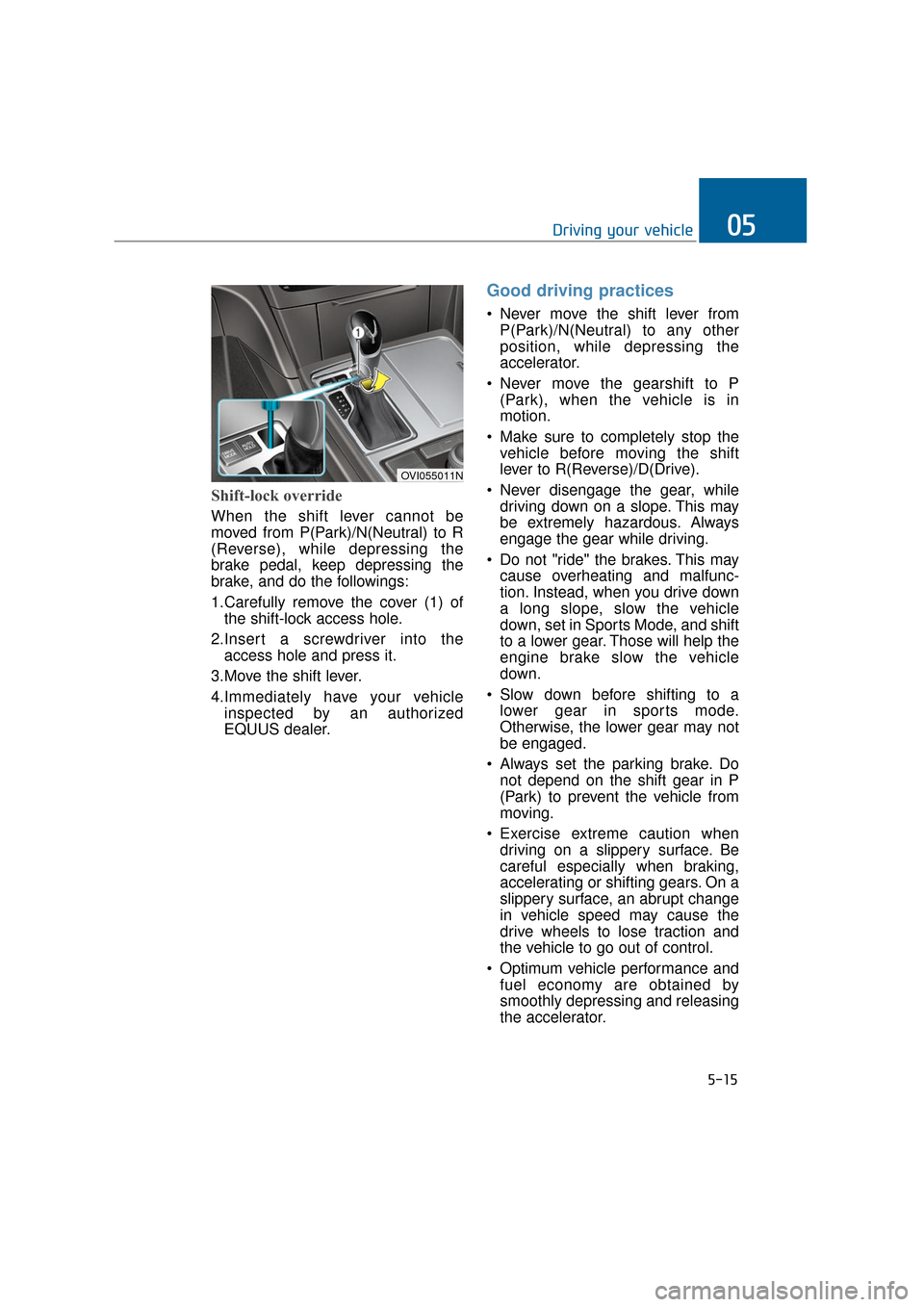
Shift-lock override
When the shift lever cannot be
moved from P(Park)/N(Neutral) to R
(Reverse), while depressing the
brake pedal, keep depressing the
brake, and do the followings:
1.Carefully remove the cover (1) ofthe shift-lock access hole.
2.Insert a screwdriver into the access hole and press it.
3.Move the shift lever.
4.Immediately have your vehicle inspected by an authorized
EQUUS dealer.
Good driving practices
Never move the shift lever fromP(Park)/N(Neutral) to any other
position, while depressing the
accelerator.
Never move the gearshift to P (Park), when the vehicle is in
motion.
Make sure to completely stop the vehicle before moving the shift
lever to R(Reverse)/D(Drive).
Never disengage the gear, while driving down on a slope. This may
be extremely hazardous. Always
engage the gear while driving.
Do not "ride" the brakes. This may cause overheating and malfunc-
tion. Instead, when you drive down
a long slope, slow the vehicle
down, set in Sports Mode, and shift
to a lower gear. Those will help the
engine brake slow the vehicle
down.
Slow down before shifting to a lower gear in sports mode.
Otherwise, the lower gear may not
be engaged.
Always set the parking brake. Do not depend on the shift gear in P
(Park) to prevent the vehicle from
moving.
Exercise extreme caution when driving on a slippery surface. Be
careful especially when braking,
accelerating or shifting gears. On a
slippery surface, an abrupt change
in vehicle speed may cause the
drive wheels to lose traction and
the vehicle to go out of control.
Optimum vehicle performance and fuel economy are obtained by
smoothly depressing and releasing
the accelerator.
5-15
Driving your vehicle05
OVI055011N
Page 280 of 477
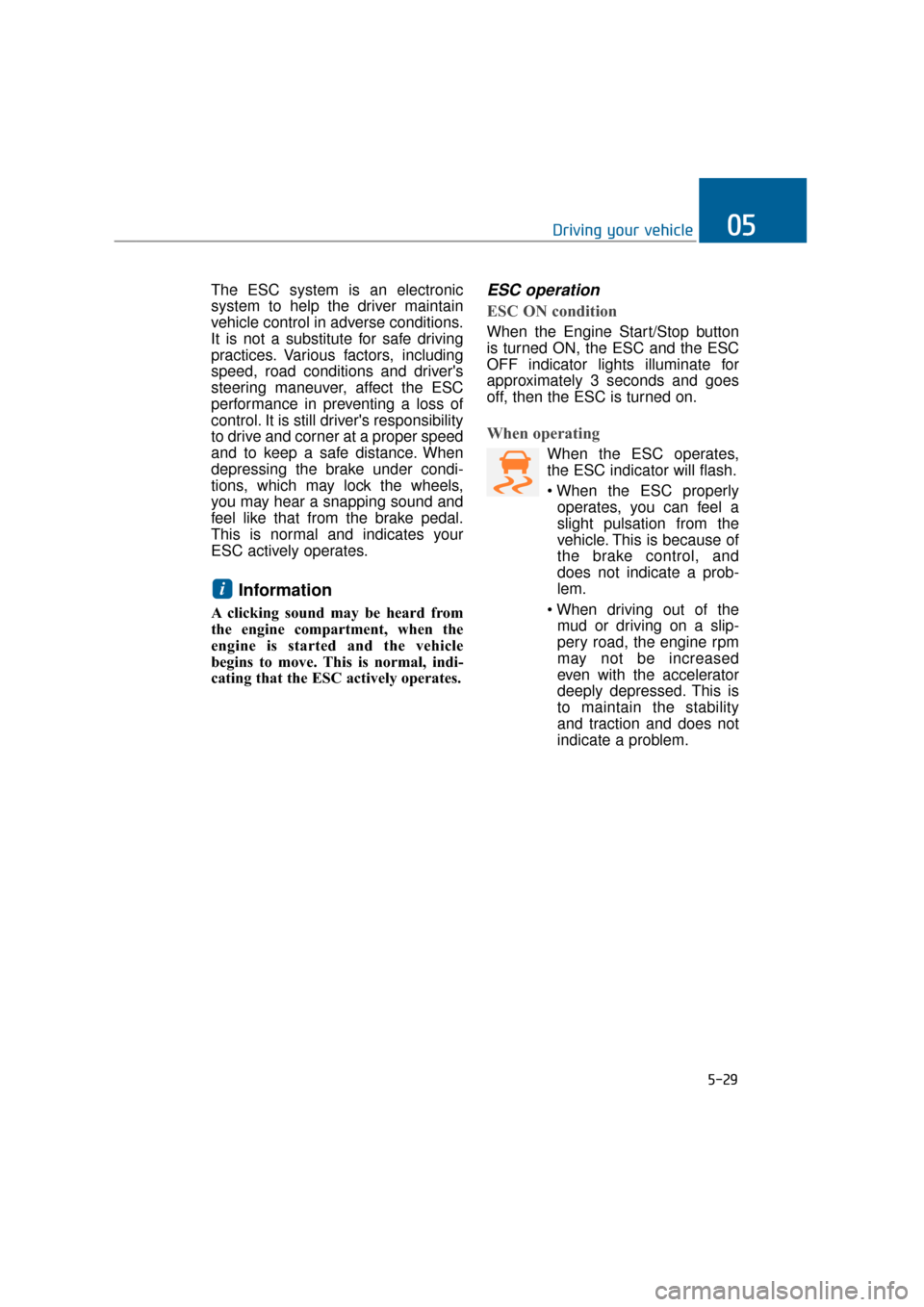
The ESC system is an electronic
system to help the driver maintain
vehicle control in adverse conditions.
It is not a substitute for safe driving
practices. Various factors, including
speed, road conditions and driver's
steering maneuver, affect the ESC
performance in preventing a loss of
control. It is still driver's responsibility
to drive and corner at a proper speed
and to keep a safe distance. When
depressing the brake under condi-
tions, which may lock the wheels,
you may hear a snapping sound and
feel like that from the brake pedal.
This is normal and indicates your
ESC actively operates.
Information
A clicking sound may be heard from
the engine compartment, when the
engine is started and the vehicle
begins to move. This is normal, indi-
cating that the ESC actively operates.
ESC operation
ESC ON condition
When the Engine Start/Stop button
is turned ON, the ESC and the ESC
OFF indicator lights illuminate for
approximately 3 seconds and goes
off, then the ESC is turned on.
When operating
When the ESC operates,
the ESC indicator will flash.
operates, you can feel a
slight pulsation from the
vehicle. This is because of
the brake control, and
does not indicate a prob-
lem.
mud or driving on a slip-
pery road, the engine rpm
may not be increased
even with the accelerator
deeply depressed. This is
to maintain the stability
and traction and does not
indicate a problem.
i
5-29
Driving your vehicle05
Page 281 of 477
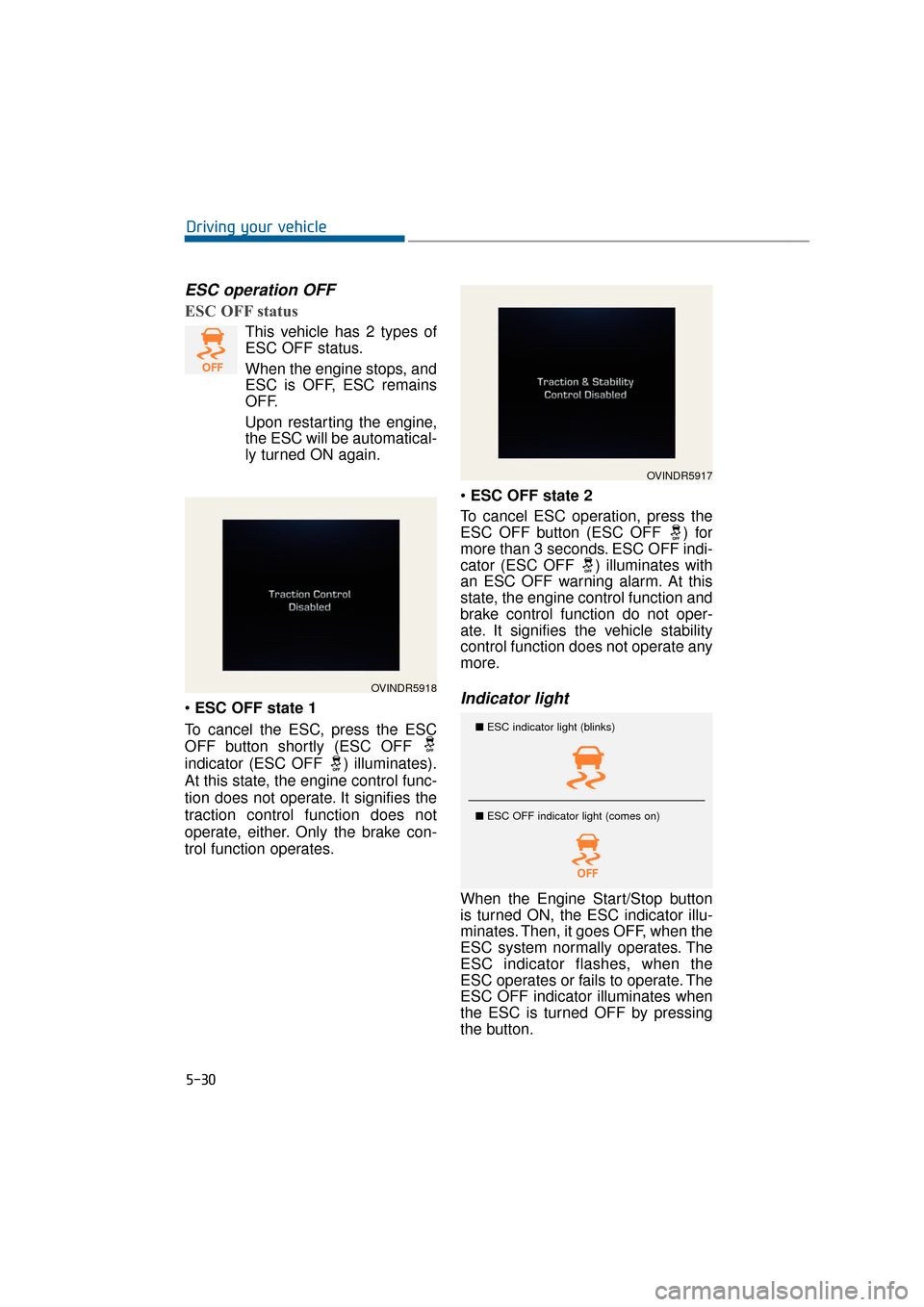
ESC operation OFF
ESC OFF status
This vehicle has 2 types of
ESC OFF status.
When the engine stops, and
ESC is OFF, ESC remains
OFF.
Upon restarting the engine,
the ESC will be automatical-
ly turned ON again.
ESC OFF state 1
To cancel the ESC, press the ESC
OFF button shortly (ESC OFF
indicator (ESC OFF ) illuminates).
At this state, the engine control func-
tion does not operate. It signifies the
traction control function does not
operate, either. Only the brake con-
trol function operates.
ESC OFF state 2
To cancel ESC operation, press the
ESC OFF button (ESC OFF ) for
more than 3 seconds. ESC OFF indi-
cator (ESC OFF ) illuminates with
an ESC OFF warning alarm. At this
state, the engine control function and
brake control function do not oper-
ate. It signifies the vehicle stability
control function does not operate any
more.
Indicator light
When the Engine Start/Stop button
is turned ON, the ESC indicator illu-
minates. Then, it goes OFF, when the
ESC system normally operates. The
ESC indicator flashes, when the
ESC operates or fails to operate. The
ESC OFF indicator illuminates when
the ESC is turned OFF by pressing
the button.
5-30
Driving your vehicle
OVINDR5917
OVINDR5918
■ ESC indicator light (blinks)
■ ESC OFF indicator light (comes on)
Page 322 of 477
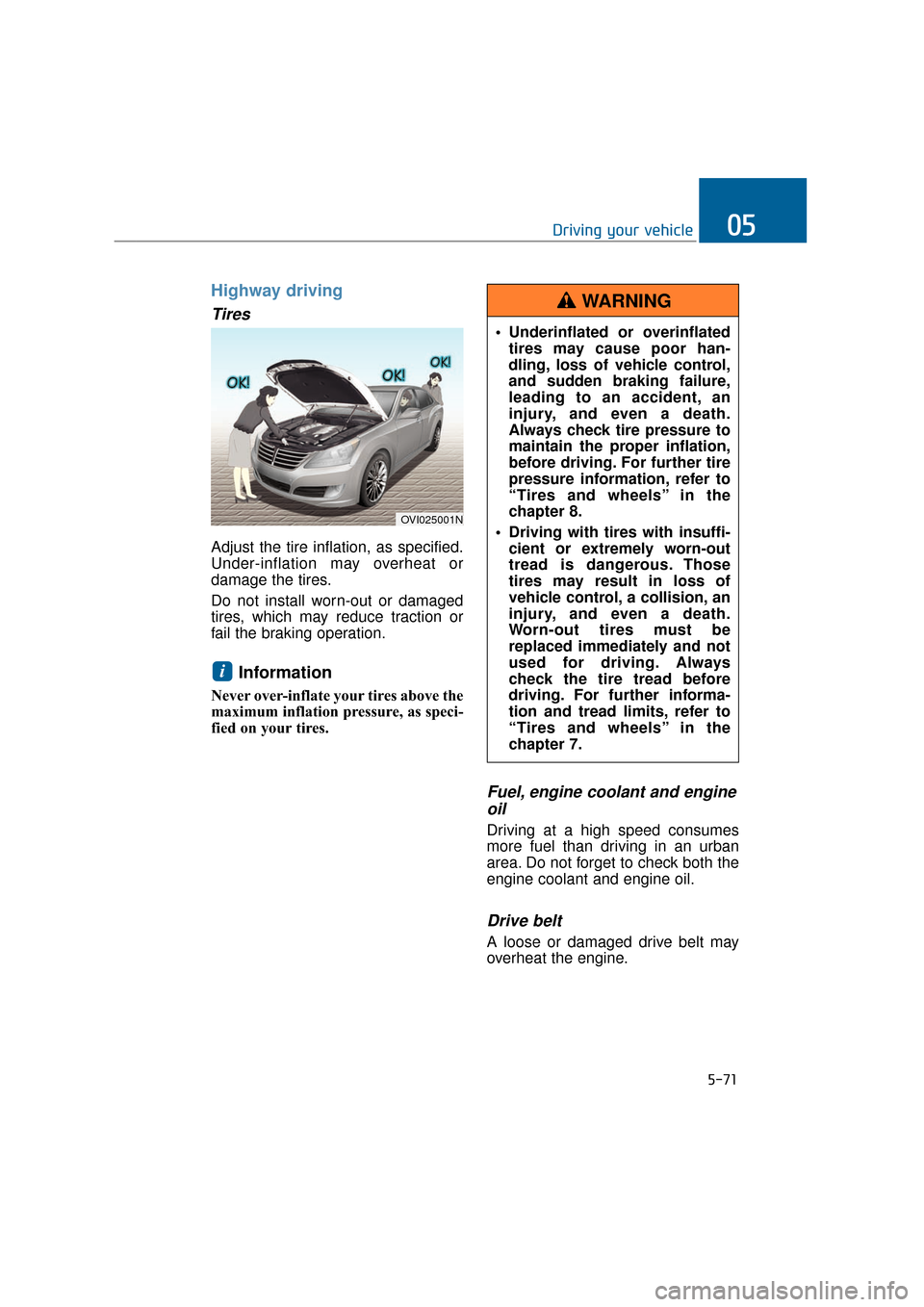
5-71
Driving your vehicle05
Highway driving
Tires
Adjust the tire inflation, as specified.
Under-inflation may overheat or
damage the tires.
Do not install worn-out or damaged
tires, which may reduce traction or
fail the braking operation.
Information
Never over-inflate your tires above the
maximum inflation pressure, as speci-
fied on your tires.
Fuel, engine coolant and engineoil
Driving at a high speed consumes
more fuel than driving in an urban
area. Do not forget to check both the
engine coolant and engine oil.
Drive belt
A loose or damaged drive belt may
overheat the engine.
i
OVI025001N
Underinflated or overinflated
tires may cause poor han-
dling, loss of vehicle control,
and sudden braking failure,
leading to an accident, an
injury, and even a death.
Always check tire pressure to
maintain the proper inflation,
before driving. For further tire
pressure information, refer to
“Tires and wheels” in the
chapter 8.
Driving with tires with insuffi- cient or extremely worn-out
tread is dangerous. Those
tires may result in loss of
vehicle control, a collision, an
injury, and even a death.
Worn-out tires must be
replaced immediately and not
used for driving. Always
check the tire tread before
driving. For further informa-
tion and tread limits, refer to
“Tires and wheels” in the
chapter 7.
WARNING
Page 359 of 477
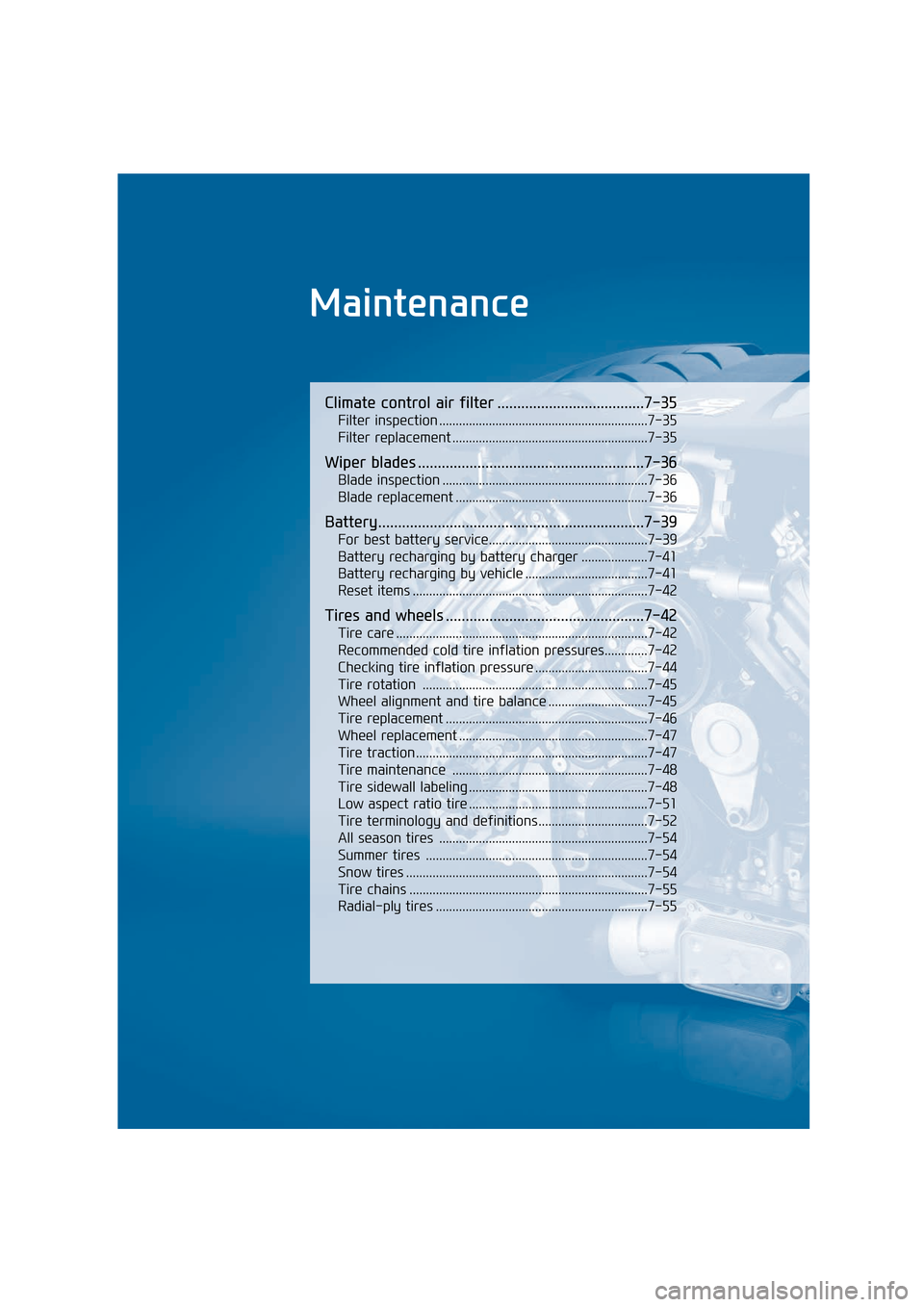
Maintenance
Climate control air filter .....................................7-35
Filter inspection ...............................................................7-35
Filter replacement ...........................................................7-35
Wiper blades .........................................................7-36
Blade inspection ..............................................................7-36
Blade replacement ..........................................................7-36
Battery...................................................................7-39
For best battery service................................................7-39
Battery recharging by battery charger ....................7-41
Battery recharging by vehicle .....................................7-41
Reset items .......................................................................7\
-42
Tires and wheels ..................................................7-42
Tire care ........................................................................\
....7-42
Recommended cold tire inflation pressures.............7-42
Checking tire inflation pressure ..................................7-44
Tire rotation ....................................................................7-45\
Wheel alignment and tire balance ..............................7-45
Tire replacement .............................................................7-46
Wheel replacement .........................................................7-47
Tire traction ......................................................................7-\
47
Tire maintenance ...........................................................7-48
Tire sidewall labeling ......................................................7-48
Low aspect ratio tire ......................................................7-51
Tire terminology and definitions.................................7-52
All season tires ...............................................................7-54
Summer tires ...................................................................7-54
Snow tires ........................................................................\
.7-54
Tire chains ........................................................................\
7-55
Radial-ply tires ................................................................7-55
Page 403 of 477
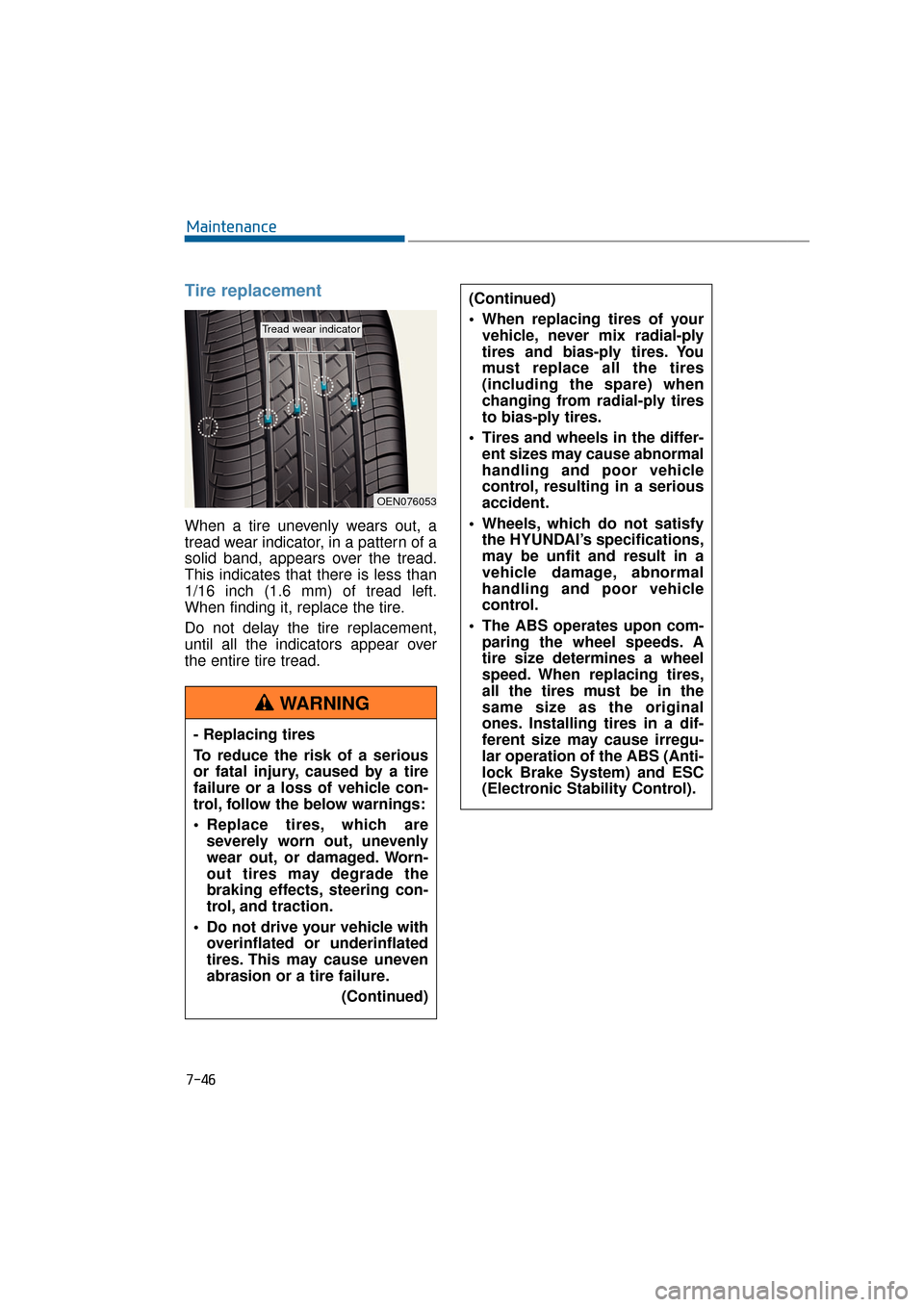
7-46
Maintenance
Tire replacement
When a tire unevenly wears out, a
tread wear indicator, in a pattern of a
solid band, appears over the tread.
This indicates that there is less than
1/16 inch (1.6 mm) of tread left.
When finding it, replace the tire.
Do not delay the tire replacement,
until all the indicators appear over
the entire tire tread.
OEN076053
Tread wear indicator
- Replacing tires
To reduce the risk of a serious
or fatal injury, caused by a tire
failure or a loss of vehicle con-
trol, follow the below warnings:
Replace tires, which areseverely worn out, unevenly
wear out, or damaged. Worn-
out tires may degrade the
braking effects, steering con-
trol, and traction.
Do not drive your vehicle with overinflated or underinflated
tires. This may cause uneven
abrasion or a tire failure.
(Continued)
(Continued)
When replacing tires of yourvehicle, never mix radial-ply
tires and bias-ply tires. You
must replace all the tires
(including the spare) when
changing from radial-ply tires
to bias-ply tires.
Tires and wheels in the differ- ent sizes may cause abnormal
handling and poor vehicle
control, resulting in a serious
accident.
Wheels, which do not satisfy the HYUNDAI’s specifications,
may be unfit and result in a
vehicle damage, abnormal
handling and poor vehicle
control.
The ABS operates upon com- paring the wheel speeds. A
tire size determines a wheel
speed. When replacing tires,
all the tires must be in the
same size as the original
ones. Installing tires in a dif-
ferent size may cause irregu-
lar operation of the ABS (Anti-
lock Brake System) and ESC
(Electronic Stability Control).
WARNING
Page 404 of 477
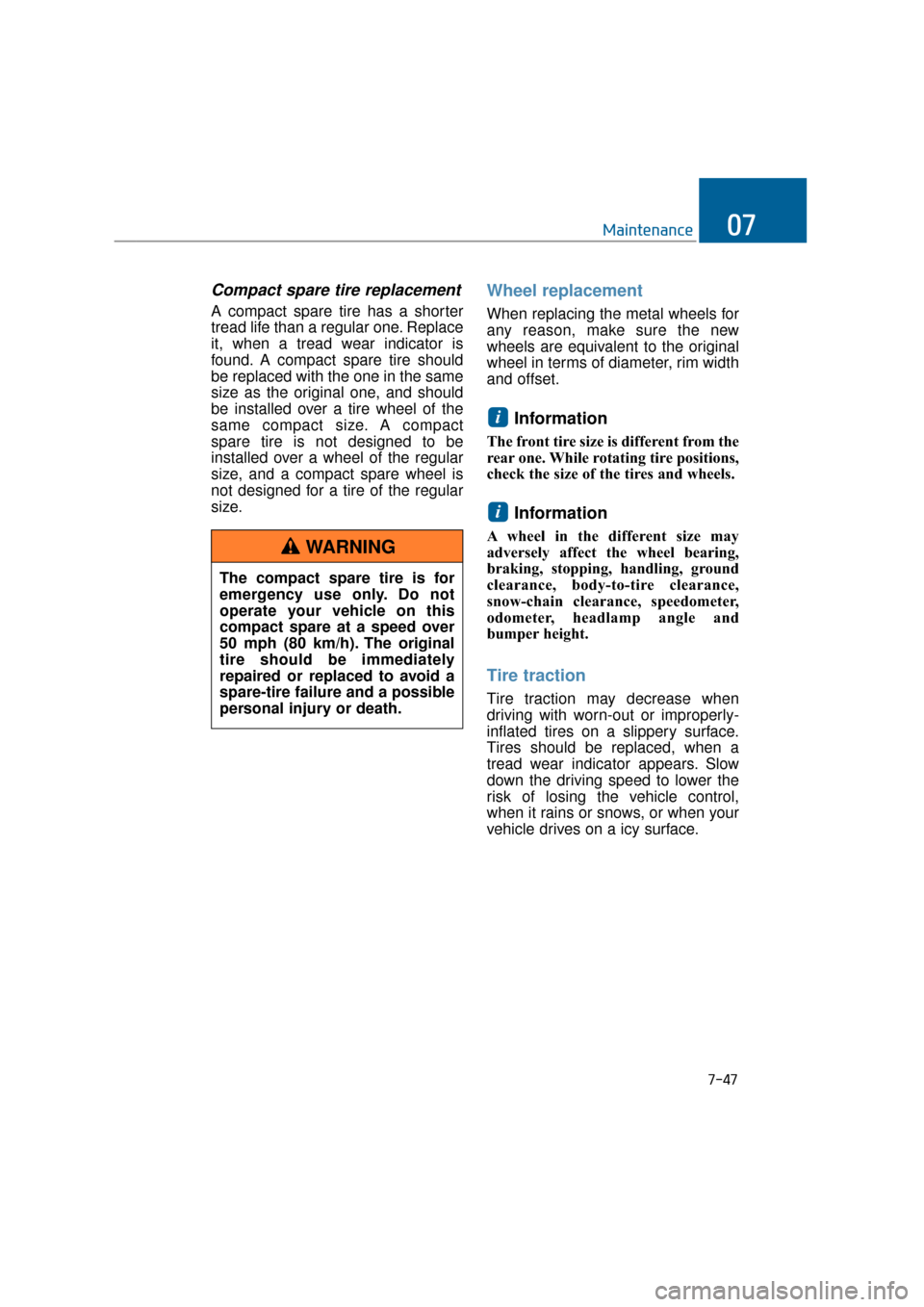
7-47
Maintenance07
Compact spare tire replacement
A compact spare tire has a shorter
tread life than a regular one. Replace
it, when a tread wear indicator is
found. A compact spare tire should
be replaced with the one in the same
size as the original one, and should
be installed over a tire wheel of the
same compact size. A compact
spare tire is not designed to be
installed over a wheel of the regular
size, and a compact spare wheel is
not designed for a tire of the regular
size.
Wheel replacement
When replacing the metal wheels for
any reason, make sure the new
wheels are equivalent to the original
wheel in terms of diameter, rim width
and offset.
Information
The front tire size is different from the
rear one. While rotating tire positions,
check the size of the tires and wheels.
Information
A wheel in the different size may
adversely affect the wheel bearing,
braking, stopping, handling, ground
clearance, body-to-tire clearance,
snow-chain clearance, speedometer,
odometer, headlamp angle and
bumper height.
Tire traction
Tire traction may decrease when
driving with worn-out or improperly-
inflated tires on a slippery surface.
Tires should be replaced, when a
tread wear indicator appears. Slow
down the driving speed to lower the
risk of losing the vehicle control,
when it rains or snows, or when your
vehicle drives on a icy surface.
i
i
The compact spare tire is for
emergency use only. Do not
operate your vehicle on this
compact spare at a speed over
50 mph (80 km/h). The original
tire should be immediately
repaired or replaced to avoid a
spare-tire failure and a possible
personal injury or death.
WARNING
Page 407 of 477
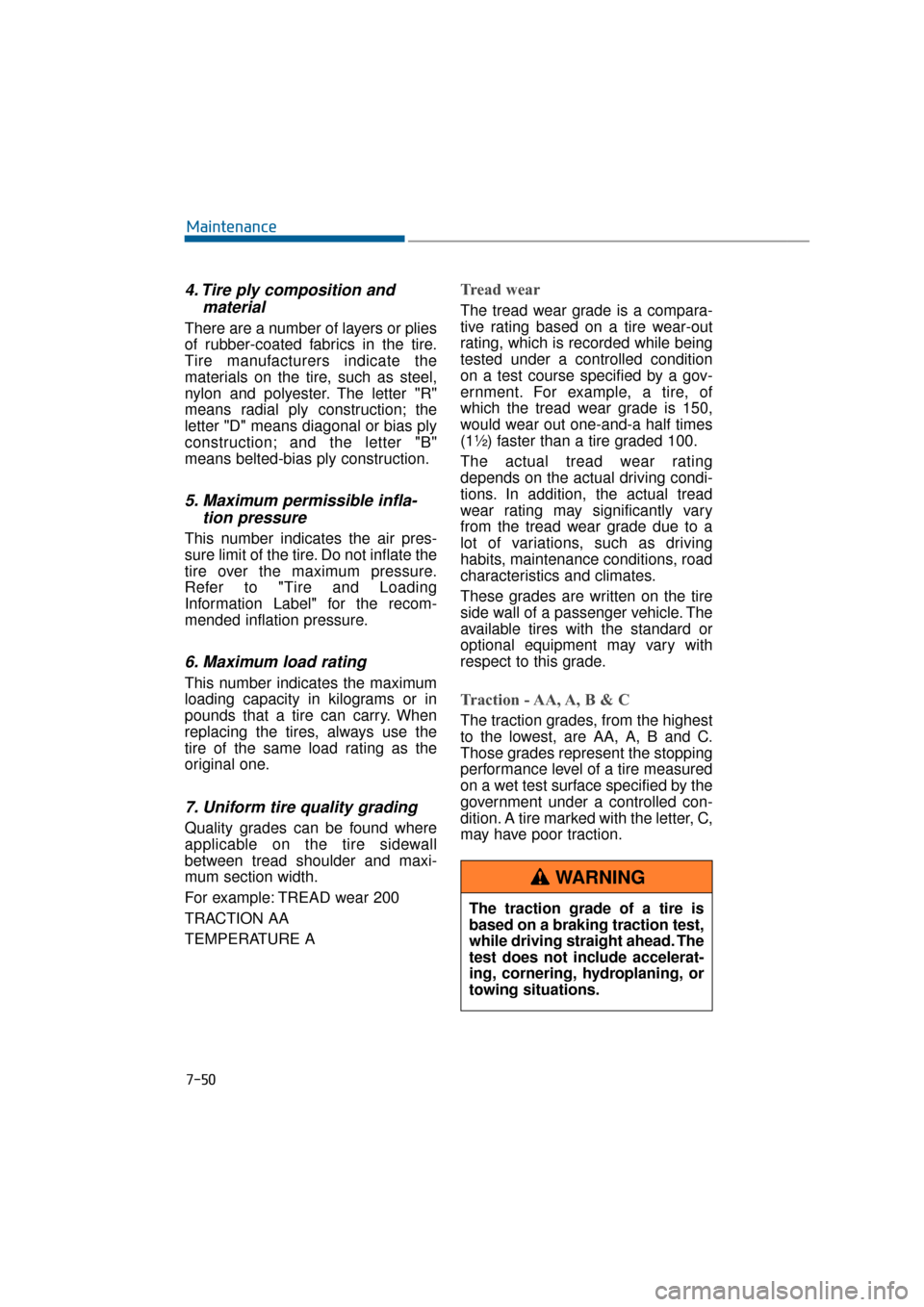
7-50
Maintenance
4. Tire ply composition andmaterial
There are a number of layers or plies
of rubber-coated fabrics in the tire.
Tire manufacturers indicate the
materials on the tire, such as steel,
nylon and polyester. The letter "R"
means radial ply construction; the
letter "D" means diagonal or bias ply
construction; and the letter "B"
means belted-bias ply construction.
5. Maximum permissible infla-tion pressure
This number indicates the air pres-
sure limit of the tire. Do not inflate the
tire over the maximum pressure.
Refer to "Tire and Loading
Information Label" for the recom-
mended inflation pressure.
6. Maximum load rating
This number indicates the maximum
loading capacity in kilograms or in
pounds that a tire can carry. When
replacing the tires, always use the
tire of the same load rating as the
original one.
7. Uniform tire quality grading
Quality grades can be found where
applicable on the tire sidewall
between tread shoulder and maxi-
mum section width.
For example: TREAD wear 200
TRACTION AA
TEMPERATURE A
Tread wear
The tread wear grade is a compara-
tive rating based on a tire wear-out
rating, which is recorded while being
tested under a controlled condition
on a test course specified by a gov-
ernment. For example, a tire, of
which the tread wear grade is 150,
would wear out one-and-a half times
(1½) faster than a tire graded 100.
The actual tread wear rating
depends on the actual driving condi-
tions. In addition, the actual tread
wear rating may significantly vary
from the tread wear grade due to a
lot of variations, such as driving
habits, maintenance conditions, road
characteristics and climates.
These grades are written on the tire
side wall of a passenger vehicle. The
available tires with the standard or
optional equipment may vary with
respect to this grade.
Traction - AA, A, B & C
The traction grades, from the highest
to the lowest, are AA, A, B and C.
Those grades represent the stopping
performance level of a tire measured
on a wet test surface specified by the
government under a controlled con-
dition. A tire marked with the letter, C,
may have poor traction.
The traction grade of a tire is
based on a braking traction test,
while driving straight ahead. The
test does not include accelerat-
ing, cornering, hydroplaning, or
towing situations.
WARNING